#rodentcompetition2023
Text
Round 1.3
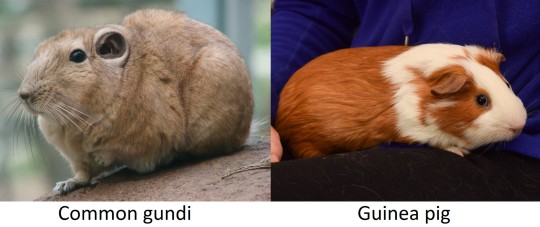
Information about contestants below!
Common gundi (Ctenodactylus gundi)
It resembles a guinea pig in appearance, having big eyes, flat ears and short limbs. Each foot has four digits and sharp, dark claws; the two hind feet have comblike bristles between the claws. Gundi's teeth are rootless.
Diurnal and herbivorous. Lives in rocky, arid places, making its home in crevices and under boulders. These homes are usually temporary. In the early morning, gundis sunbathe. Once it's hot enough, they will forage and eat, then go back to sunbathing on warm rocks.
Gundi does not drink, obtaining sufficient water from its diet, nor does it store food as do some desert rodents. Gundis make chirp-like sounds to communicate with each other. If alarmed, they thump their hind feet as well. The gundi is a territorial species, with family groups of between three and eleven adults defending a territory. They sleep in piles to stay warm during the winter.
The parasitic organism Toxoplasma gondii was first described in 1908 within the tissues of the gundi.
Guinea pig (Cavia porcellus)
Guinea pig is not found naturally in the wild; it is likely descended from closely related species of cavies. The guinea pig was first domesticated as early as 5000 BC.
They can learn complex paths to food, and can accurately remember a learned path for months. Their strongest problem-solving strategy is motion. When happily excited, guinea pigs may perform little hops in the air. Guinea pigs are also good swimmers. They have well-developed senses of hearing, smell, and touch. Vocalization is the primary means of communication between members of the species. Like many rodents, guinea pigs sometimes participate in social grooming, and they regularly self-groom.
The guinea pig's natural diet is grass. Like humans, but unlike most other mammals, guinea pigs cannot synthesize their own vitamin C and must obtain this vital nutrient from food. They live an average of four to five years, but may live as long as eight years.
53 notes
·
View notes
Text
Round 1.6

Information about contestants below!
Spix's yellow-toothed cavy (Galea spixii)
Their fur is gray tinged, with brown back, light sides, and whitish abdomen. Incisors are yellow. Herbivorous, foraging on grasses and other low vegetation.
They are found in open savanna and semiarid habitats. Spix’s Yellow-toothed Cavies form well-marked runways that they use regularly. They also clear small areas for sand bathing. They do not construct burrows, likely due to extremely rocky soil but they construct temporary nest sites under rocks or low vegetation. They are terrestrial animals with diurnal habits, but sporadically active at night.
Litter size ranges from one to five, with an average of three. They have hair and open eyes at birth. Males and females in this species are aggressive to each other. Three subspecies are recognized.
Capybara or greater capybara (Hydrochoerus hydrochaeris)
Capybara is the largest living rodent and grows to 106–134 cm in length. It inhabits savannas and dense forests, and lives near bodies of water. It is a highly social species and can be found in groups as large as 100 individuals, but usually live in groups of 10–20 individuals.
Capybaras have a heavy, barrel-shaped body and short head, with reddish-brown fur on the upper part of their body that turns yellowish-brown underneath. They have slightly webbed feet and vestigial tails.
Though quite agile on land, capybaras are equally at home in the water. They are excellent swimmers and can remain completely submerged for up to five minutes. They can sleep in water, keeping only their noses out. Capybaras are herbivores and are very selective feeders.
31 notes
·
View notes
Text
Hello, welcome to rodent competition where we'll be choosing tumblr's favourite real life rodent :D
You can submit any amount of rodents you want but please don't submit same one multiple times
Specify species, e.g. write black rat, not just rat. there's many of them ^^
Only real life animals that belong to Rodentia order. No Remy or rabbits, sorry <3
submit them here!!!
inspired by other nature tournaments like @treebattleroyal @snakeswagbracket @may-the-best-penguin-win @mushroom-showdown @dailylepidopterans
Have fun! ^^
52 notes
·
View notes
Text
Round 1.2

Information about contestants below!
Horned gopher (Ceratogaulus sp.)
Horned gophers are extinct rodents that lived from the late Miocene to the early Pliocene epochs. They had two horns; these were large (in comparison to body size), paired, and originated from the nasal bones. Horned gophers are the smallest known horned mammals and the only known rodents ever to have had horns.
The role of the horns is subject to much speculation. Several functions have been hypothesized including digging, mating displays or combat, and defense from predators. The horns are not sexually dimorphic and multiple analyses support a role in defense.
In other respects, horned gophers most resembled modern marmots. They were approximately 30 cm long, and had paddle-like forepaws with powerful claws adapted for digging. They also had small eyes, and probably had poor eyesight, similar to that of a mole. These features, and morphology analyses suggest that they were likely burrowing animals.
Common degu (Octodon degus)
It has yellow-brown fur above and creamy-yellow below. The tail is long, thin, with a tufted, black tip. Its cheek teeth are shaped like figures-of-eight, hence the degu's genus name Octodon.
Degus are highly social. They live in burrows, and, by digging communally, they are able to construct larger and more elaborate burrows than they could on their own. Females living in the same group nest communally and nurse one another's young. Unlike most other rodents, male common degus also take part in protecting and raising their pups. They are strictly herbivorous.
Degus exhibit a wide array of communication techniques. They have an elaborate vocal repertoire comprising up to 15 different sounds. Degus are diurnal and have good vision, they are extremely intelligent and have a good ability to solve problems. After initial interest as research subjects, they have become popular as pets. The average lifespan in captivity is around 6-8 years.
#round 1#rodentcompetition2023#horned gopher#common degu#tournament poll#poll in which I have a favourite
21 notes
·
View notes
Text
Round 1.1
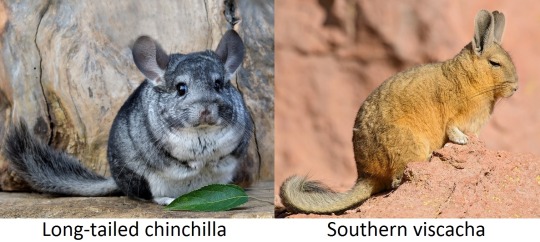
Information about contestants below!
Long-tailed chinchilla (Chinchilla lanigera)
Chinchillas have the densest fur of all mammals that live on land. Their bodies are covered in 20,000 hairs, with up to 75 hairs growing from each follicle. The general color of their upper parts is bluish or silvery gray; the underparts are yellowish-white. The tail has long, coarse, gray and black hairs.
Chinchillas live in burrows or rock crevices at elevations of about 3,000 to 5,000 m. They live in groups that can range from 14 members up to 100. Typically monogamous. Chinchillas are agile jumpers and can jump up to 1.8 m. They eat plant leaves, fruits, seeds, and small insects.
Domestic chinchillas are kept as pets and are also used in research. They are listed as Endangered due to a severe population loss. In the wild, the average life-span is 10 years; however, they could live up to 20 years in human care.
Southern viscacha (Lagidium viscacia)
The southern viscacha has yellowish-grey upperparts and paler underparts. It has long ears and hind legs and resembles a rabbit in appearance apart from its long, bushy tail. The body fur is long and soft, while that on the tail is coarse.
It is a colonial animal living in small groups in rocky mountain areas, where the vegetation is sparse. Its elevation range is about 700 to 5,100 m above sea level. Viscacha does not hibernate and is mostly active soon after dawn and again in the evening. It eats mostly grasses, moss and lichens.
Part of the day is spent perched on a rock sunbathing, grooming, or resting. They do not venture far from rocks so that they can plunge underground if danger threatens. They use various calls to communicate with each other. The average lifespan is unknown, but one individual survived for 19 years in captivity.
30 notes
·
View notes
Text
Preliminaries

Information about contestants below!
Nutria or coypu (Myocastor coypus)
Nutria is a large, herbivorous, semiaquatic rodent. It lives in burrows alongside stretches of water and feeds on river plant stems. It somewhat resembles a very large rat, or a beaver with a small, long and skinny hairless tail. Three distinguishing features are a white patch on the muzzle, webbed hind feet, and large, bright orange-yellow incisors.
Nutria are found most commonly in freshwater marshes and wetlands. They either construct their own burrows, or occupy burrows abandoned by other animals. They are also capable of constructing floating rafts out of vegetation. Nutria live in partially underwater dens. One male will share a den with three or four females and their offspring.
Nutria can live up to six years in captivity, but individuals uncommonly live past three years old. It is considered an invasive species in Europe.
Desmarest's hutia or Cuban hutia (Capromys pilorides)
It is the largest living hutia. It has thick, coarse fur which extends to the tip of the tail. The colour of the body fur varies from black to brown, with a light sand colour and red also seen.
The Desmarest's hutia is found only in Cuba, but is widespread throughout its range. In northern Cuba, populations tend to be centred on areas where there are abundant mangroves, while southern populations tend to favour a more terrestrial habitat.
Desmarest's hutias normally live in pairs, but can be found individually or in small groups. They are diurnal and do not burrow, so during the night they rest in hollows in rocks or trees. They are omnivorous but eat mostly bark, leaves and fruit. In captivity they live for eight to eleven years.
Muskrat (Ondatra zibethicus)
They are covered with short, thick fur of medium to dark brown color. They have long tails covered with scales. To aid in swimming, their tails are slightly flattened vertically, a shape that is unique to them. Muskrats spend most of their time in the water and can swim underwater for 12 to 17 minutes.
The muskrat mostly inhabit wetlands. They live in families, consisting of a male and female pair and their young. They build nests that are often burrowed into the bank with an underwater entrance. Muskrats feed mostly on cattail and other aquatic vegetation but also eat small animals.
Their bodies, like those of seals and whales, are less sensitive to the buildup of carbon dioxide than those of most other mammals. They can close off their ears to keep water out. In some European countries the muskrat is considered an invasive species.
19 notes
·
View notes
Text
Round 1.4
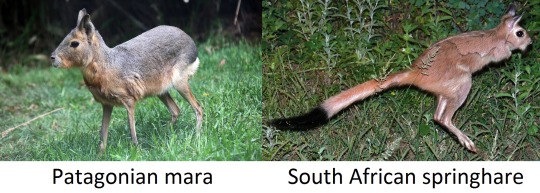
Information about contestants below!
Patagonian mara (Dolichotis patagonum)
Patagonian mara resembles a jackrabbit. It has distinctive long ears and long limbs. The feet are compressed, making them hoof-like. It’s a relatively large rodent with head and body length of 69–75 cm. Primarily diurnal. They prefer to live in habitats with shrub cover. Maras feed primarily on green vegetation and fruit. When running, they have been compared to deer and antelope.
Their social organizations have a unique combination of monogamy and communal breeding. Dens are dug during the breeding season for the young to be raised. Communal living provides protection from predators with the survival rate for young being higher in larger groups than in smaller groups.
Patagonian maras are found only in Argentina and are considered to be a near threatened species.
South African springhare (Pedetes capensis)
It’s a medium-sized terrestrial and burrowing rodent. It resembles a small kangaroo with well-developed hind legs, short front legs, and a long tail which comprises half of its body length. As well as a long tail, springhares have relatively large eyes and ears. Similar to kangaroos, they also use their tails for balance. Springhares are reported to be able to make hops of 20 cm and leaps of 2 m.
The colour of springhare varies from a reddish-brown on its upperparts to an off-white belly and a black tip on the tail. Their fur is biofluorescent.
Springhares are nocturnal animals, who forage during the night and retreat to a burrow during the day. Herbivorous, however, they are picky eaters and often leave abundant plant materials behind in their feeding grounds.
13 notes
·
View notes
Text
Preliminaries
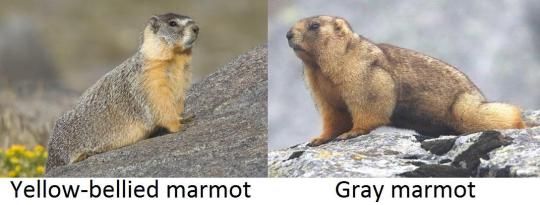
Information about contestants bellow!
Yellow-bellied marmot (Marmota flaviventris)
Usually weigh 1.6–5.2 kg when fully grown. The weight fluctuates quite drastically through the year as they gain additional fat reserves in the autumn, in preparation for hibernation. The back is reddish-brown in color with grizzled black and light-grey tan. The belly is yellowish to dark brown.
It inhabits steppes, meadows, talus fields, and other open habitats. Typically live above 2,000 m. They choose to dig burrows under rocks, as it is less likely to be visible to predators. Upon seeing a predator, it whistles to warn the others in the area. They live in colonies of about ten to twenty individuals with a single dominant male. The hibernating burrows can be up to 5–7 m deep; however, the burrows constructed for daily use are usually only 1 m deep.
Yellow-bellied marmots are diurnal. They are omnivores, but generally eat a wide variety of plants, as they are generalist herbivores.
Gray marmot or Altai marmot (Marmota baibacina)
One of the largest palearctic species, with some individuals reaching near 8 kg before hibernation. Body size varies based on the time of year, and with latitude and elevation. The back is beige to tan with brown to black hairs. The belly is more orange-reddish brown. Albinism occurs in this species.
Gray marmots live in mountain meadows and steppes, and occur in elevations from 150 to 4,000 m. They dig extensive winter burrows for hibernation, reaching depths of 5–7 m with some tunnels up to 63 m long. Winter burrows hold ten or more individuals which helps them stay warm with less energy use. Summer burrows are less deep and hold only a few individuals. They live in social groups with several burrows forming a colony.
Gray marmots have species specific alarm calls, which can be used to distinguish them from other species.
11 notes
·
View notes
Text
Preliminaries

Information about contestants below!
Douglas squirrel (Tamiasciurus douglasii)
Sometimes known as the chickaree or pine squirrel. The Native Americans of Kings River called it the "Pillillooeet", in imitation of its characteristic alarm call.
Their appearance varies according to the season. In the summer, they are greyish on their backs and pale orange on the chest and belly. In the winter, the coat is browner and the underside is grayer.
Mostly eat seeds of coniferous trees. They are hoarders, storing their food in a single location. Diurnal. On summer nights, they sleep in ball-shaped nests that they make in the trees, but in the winter they use holes in trees as nests. Territorial; in winter, each squirrel occupies a territory of about 10 000 square metres, but during the breeding season a mated pair will defend a single territory together.
Abert's squirrel or the tassel-eared squirrel (Sciurus aberti)
It is named in honor of the American naturalist John James Abert. It is recognizable by its tufted ears, gray color and rusty stripe on back.
Diurnal. Mostly feeds on the seeds and cones of the Mexican pinyon and the ponderosa pine. It doesn't store food, as other North American squirrels do. Nine subspecies are recognised.
Breeding normally occurs in summer, with a spherical nest being built high in the canopy. It's used year-round by most squirrels for nightly shelter. Three or four young per litter is typical, usually bear one litter per year.
Calabrian black squirrel (Sciurus meridionalis)
It has long been considered a subspecies of the red squirrel, but studies revealed that it is unique in both genetics and appearance, leading to its recognition as a distinct species. It generally resembles the red squirrel in its behavior.
It is monomorphic (not variable in appearance), being very dark brown to blackish with contrasting white underparts. Compared to red squirrels, the Calabrian black squirrel is also significantly larger, weighing on average about 35% more.
Lives in mixed forests in highlands, its nests are often placed in pine or oak trees, mostly near black pine, as the seeds are an important food source.
#preliminaries#rodentcompetition2023#tournament poll#douglas squirrel#albert's squirrel#calabrian black squirrel
12 notes
·
View notes
Text
Preliminaries

Information about contestants below!
Winter white dwarf hamster (Phodopus sungorus)
It has a dark grey dorsal stripe and furry feet. In winter the dark fur is almost entirely replaced with white fur. This adaptation helps them to evade predators in the snow-covered steppes. In captivity, this does not usually happen. The length is 7–9 cm. Body weight changes dramatically throughout the year, from 19 to 45 g.
The hamster digs tunnels one meter deep leading to ground burrows, most of them have six entrances. To keep the burrow warm in the winter, the hamster closes all but one entrance and lines the burrows with animal fur or wool.
They are common as pets and are known to be one of the most tameable types of hamsters. Out of hamsters kept commonly as pets, only Campbell's dwarf hamster and the winter white dwarf hamster are able to interbreed and produce live hybrid offspring.
Roborovski hamster (Phodopus roborovskii)
Distinguishing characteristics of the Roborovskis are eyebrow-like white spots and the lack of any dorsal stripe.
They are found in desert regions, averaging at 4.8 cm and 12–24 g. They inhabit areas of loose sand and sparse vegetation and live at elevations of around 1,200–1,450 meters. They dig and live in burrows with steep tunnels as deep as six feet underground. In the wild they are most active at dawn and dusk.
They are omnivorous; primarily eat grains, vegetables, fruit, and plants, but they will also eat meat and insects when present. Roborovski hamsters remain underground in winter and survive in that season by stockpiling food and storing it in special food chambers within their burrow system.
Currently, 10 variations of Roborovski hamsters are thought to exist. They have become increasingly popular as pets in recent years.
12 notes
·
View notes
Text
Round 1.4

Art credit: @alphynix
Information about contestants below!
Giant pacarana (Josephoartigasia monesi)
Josephoartigasia is an extinct genus of enormous rodent from the Early Pliocene to Early Pleistocene of Uruguay.
The skull of J. monesi measures 53 cm, similar to a beef cow skull, equating to a full body length of 262.8 cm—though this is likely an overestimate—and a weight of about 480–500 kg. This makes J. monesi the biggest rodent ever discovered. Its skull was heavily reinforced to withstand high stresses far exceeding what bite force alone could exert, so it could have been using its teeth to crack nuts, excavate large burrows, dig up roots, or self defense against predators.
Josephoartigasia lived in a forested estuarine environment. Like other giant extinct rodents, it predominantly ate leaves or fruits, though the extreme bite force of J. monesi would have permitted it to consume a wide variety of different plants if necessary.
Pacarana is the closest living relative of Josephoartigasia.
Pacarana (Dinomys branickii)
Pacarana is large for a rodent, weighing up to 15 kg and measuring up to 79 cm in length, not including the thick, furry tail. It has a relatively large head with small ears and a thick neck. The fur is coarse black or brown with two white stripes grading to spots along the back and on the sides.
Pacaranas have a herbivorous diet that includes fruits, leaves, and plant shoots. They are social animals and usually live in family groups of 4 or 5 individuals. They are nocturnal and during the day they rest in caves between rocks or dens at the base of trees. Pacaranas spend most of their time on the ground, however, they are very adept climbers. They communicate with each other using various sounds, whines, songs, hisses, and tooth chattering.
In captivity pacaranas are docile and can live for 10 years or more.
#rodentcompetition2023#tournament poll#round 1#Josephoartigasia monesi#Pacarana#poll in which i have a favourite
9 notes
·
View notes
Text
Preliminaries

Information about contestants below!
Hungarian birch mouse (Sicista trizona)
It’s one of the rarest and least known small mammal species in Europe. It was once found throughout Central Europe and Romania, but is now only known from two isolated populations, each of which belong to their own subspecies. Both populations were feared to be extinct throughout much of the 20th century until being rediscovered in the 21st century.
It was long thought to be a subspecies of the southern birch mouse (S. subtilis), but a 2016 study found sufficient genetic and anatomical divergence for it to be considered its own species.
This species depends on undisturbed grassland habitat or grassland grazed by livestock, which has become rare due to mechanized agriculture. It’s classified as Endangered on the IUCN Red List.
Meadow jumping mouse (Zapus hudsonius)
A distinct characteristic about this species is its enlarged hind feet and relatively short forelimbs. This gives it a kangaroo rat-like look, although its tail, which makes up most of this creature's body length, is not bushy at the tip. The color of the fur has a few variations, but a broad dorsal stripe is always present.
They’re capable of jumping anywhere from two to three feet depending on the situation; excellent digger and a decent swimmer, also capable of diving.
Meadow jumping mice prefer a habitat which is high in humidity, like moist grasslands, and avoid heavily wooded areas. They are solitary animals, rarely if ever seen in pairs, but to contrast that, they are not aggressive towards each other either.
9 notes
·
View notes
Text
Rodent Competition 2023
Round 1

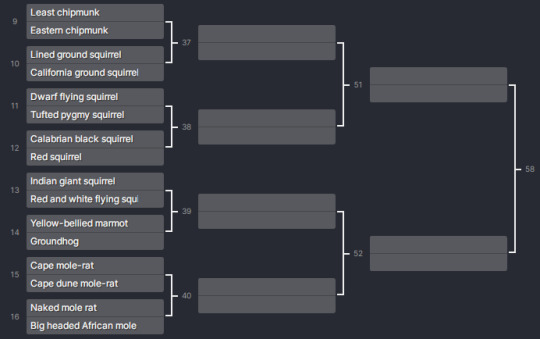
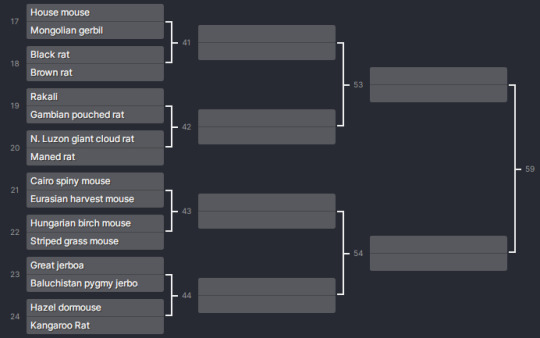

full list below!
Long-tailed chinchilla / Southern viscacha
Common degu / Horned gopher
Common gundi / Guinea pig
Josephoartigasia monesi / Pacarana
Patagonian mara / South African springhare
Spix's yellow-toothed cavy / Capybara
Central american agouti / Lowland paca
Laotian rock rat / Dassie rat
Least chipmunk / Eastern chipmunk
Thirteen-lined ground squirrel / California ground squirrel
Japanese dwarf flying squirrel / Tufted pygmy squirrel
Calabrian black squirrel / Red squirrel
Indian giant squirrel / Red and white giant flying squirrel
Yellow-bellied marmot / Groundhog
Cape mole-rat / Cape dune mole-rat
Naked mole rat / Big headed African mole rat
House mouse / Mongolian gerbil
Black rat / Brown rat
Rakali / Gambian pouched rat
Northern Luzon giant cloud rat / Maned rat
Cairo spiny mouse / Eurasian harvest mouse
Hungarian birch mouse / Striped grass mouse
Great jerboa / Baluchistan pygmy jerboa
Hazel dormouse / Kangaroo rat
Grasshopper mouse / Winter white dwarf hamster
Hatt's vesper rat / Syrian hamster
Norway lemming / Florida Mouse
European water vole / Townsend’s vole
Northern mole vole / Muskrat
Bristle-spined rat / Mountain beaver
North American beaver / Palaeocastor
Crested porcupine / North American porcupine
#rodentcompetition2023#some changes might happen#mostly if I made some mistakes#but hopefully not!#here they are :D#some names in photos are shortened to fit#tournament poll#round 1
18 notes
·
View notes
Text
#originally I planned it for current rodents only#but I definitely don't mind including them if that's what most of people will want#democracy or something :D#rodentcompetition2023
3 notes
·
View notes
Text
Some info! Currently we have 93 submissions 🥳 most of rodents were submitted only once, so many different ones :D
Current plan: have preliminaries so we would end up with 64 contestants for the main competition. During it rodents from the most submitted families will be narrowed down so we'd have more variety. Got only few extinct species so most likely they will go to main competition with everyone else :D
Will update info in case something goes wrong or we'll get huge amount of submissions in last few days. Later today I'll specify when submissions close, you still have time!
3 notes
·
View notes